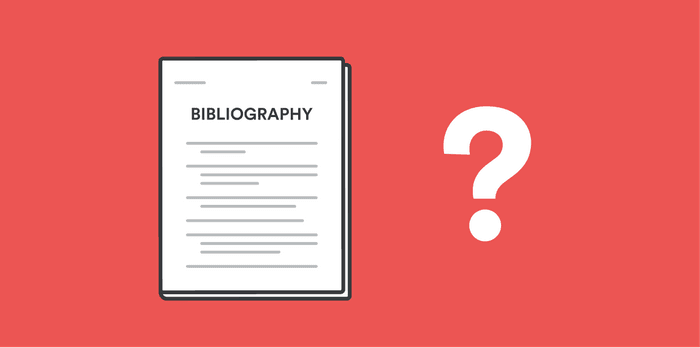
What is a bibliography? In this post, we discuss what a bibliography is and how to build one. We also cover different types of bibliographies and how to know which one is appropriate for your specific project.
What is a bibliography?
A bibliography is a complete list of the sources that you consulted and cited for your paper. It contains full bibliographic references that include various components depending of the type of source.
For instance, a reference for book source typically contains the author’s name, the title of the work, and publication information, like the date when the work was published. References for journal articles contain additional information like volume and issue number.
The term, “bibliography,” refers both to a general list of cited and consulted sources, but also to a specific type of list that is preferred by citation styles like Chicago. MLA style calls bibliographies “Works Cited,” while APA style prefers the term, “References.”
Before you create your bibliography, you should always check with your instructor to find out which citation style is required. This will determine whether you call your bibliography a “Bibliography,” “Works Cited,” or “References.”
How do you create a bibliography?
All bibliographic references have similar components, no matter what style you’re using to create your bibliography:
- Book references always contain the author’s name, the title of the book, the publisher, and the publication date.
- Journal article references also contain the author’s name, the title of the work, and the date, but also include the title of the journal, the volume and issue number where the article was found, and the page range. Journal articles found online should also include the DOI.
- Website references should feature the author’s name (if one is available), the title of the website, the date that is was published or accessed, and the URL.
To create the most accurate references for your bibliography, use BibGuru’s citation generator. You can create bibliographic citations for more than 50 source types in all of the major citation styles.
The BibGuru browser extension for Chrome and Edge can also help you instantly generate citations for online sources. Correct citations help you avoid plagiarism.
What are the different types of bibliographies?
There are two primary types of bibliographies: a traditional bibliography that simply lists the sources that you cited and/or consulted while writing your paper and an annotated bibliography, in which you include brief explanations of the content of each source and why it is important to your research.
Most annotated bibliographies include the following for each entry:
- A full bibliographic citation
- A summary of the scope of the source
- A brief summary of the source’s main argument
- An evaluation of the work’s credibility and usefulness
- A brief discussion of possible limitations of the source
Most annotations range between 100 and 300 words. Ultimately, the specific contents of your annotated bibliography will depend on the requirements of your assignment.
Bibliography example
A typical bibliography in Chicago style will look like this:
Bibliography
Grazer, Brian, and Charles Fishman. A Curious Mind: The Secret to a Bigger Life. New York: Simon & Schuster, 2015.
Keng, Shao-Hsun, Chun-Hung Lin, and Peter F. Orazem. “Expanding College Access in Taiwan, 1978–2014: Effects on Graduate Quality and Income Inequality.” Journal of Human Capital 11, no. 1 (Spring 2017): 1–34. https://doi.org/10.1086/690235.
Lahiri, Jhumpa. In Other Words. Translated by Ann Goldstein. New York: Alfred A. Knopf, 2016.
LaSalle, Peter. “Conundrum: A Story about Reading.” New England Review 38, no. 1 (2017): 95–109. Project MUSE.
Satterfield, Susan. “Livy and the Pax Deum.” Classical Philology 111, no. 2 (April 2016): 165–76.
Smith, Zadie. Swing Time. New York: Penguin Press, 2016.
Thoreau, Henry David. “Walking.” In The Making of the American Essay, edited by John D’Agata, 167–95. Minneapolis: Graywolf Press, 2016.
An entry for an annotated bibliography in Chicago style will look like this:
Davidson, Hilda Ellis. Roles of the Northern Goddess. London: Routledge, 1998.
Davidson's book provides a thorough examination of Northern Europe's major roles associated with several pagan goddesses. Some roles in everyday life include agriculture, hunting, domestic art like weaving, and death. In this book, the author discusses relevant archaeological evidence, previous research, and patterns of rituals and symbols. The book includes several photographs of relevant artifacts.
Frequently Asked Questions about what is a bibliography
⛽️ What is in a bibliography?
A bibliography contains full references for all the works that you cited or consulted for your paper.
🌋 Is a bibliography the same as references?
Yes. A bibliography contains references for the works you cited or consulted for your paper. Some citation styles, like Chicago, use the term “bibliography” to describe this list, while others, like APA, use “references.”
🚦 How do you write a bibliography?
To write a bibliography, you first need to know what citation style is required for your paper. Then, you will build entries for all of the works that you cited or consulted for your paper. These entries typically contain the author’s name, the title of the work, the publisher, and the publication date.
🏝 What are bibliography styles?
The most common styles for bibliographies are MLA, APA, Chicago, and Harvard.
🗺 Is a bibliography a works cited?
No. Typically, a works cited only contains the sources that you specifically cited in your paper. A bibliography generally features both the works you cited and any sources that you consulted during the course of your research.


